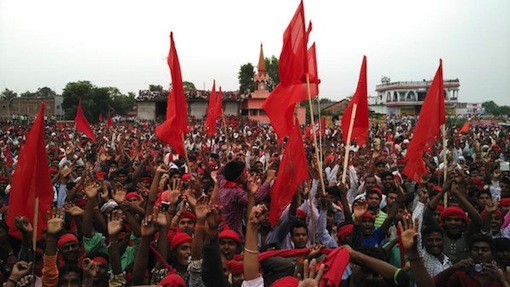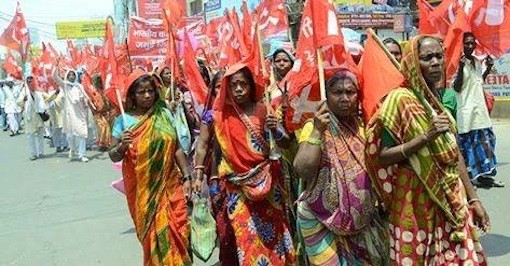
India’s elections are always a massive enterprise. In the Bihar state elections, more than half the sixty-seven million eligible voters took to the ballot to reject the Bharatiya Janata Party (BJP) and its alliance. Instead, it gave a comfortable mandate to the Mahagathbandhan (Grand Alliance), made up of the former socialist Janata parties (JDU and the RJD) and the Congress Party. The result is significant because it means that the BJP – which rules the Indian government – has been deeply embarrassed in North India, its main bastion. The Prime Minister Narendra Modi did not campaign here on issues of development, which had paid off in the national elections of 2014. He went into the gutter – dredging up the worst of his ideology (Hindutva) to cast aspersions at Muslims and at minorities in general. Modi, and his lieutenant Amit Shah, gambled on hatred. The people of Bihar rejected them.
Modi cleverly manipulated the message for the 2014 national parliamentary elections. The BJP muted its core ideology – at its center, the hatred of religious minorities – and crafted itself around the theme of development. Corruption became its adversary and development was its promise. Beneath the surface of the BJP’s Delhi press statements, more nefarious messages went to its base.
Nawada, Bihar.
Nawada is one of the southern most districts of Bihar, in the badlands of the fight between dominant caste landowners and the dispossessed. Denied of dignity and the ability to make a living, backward castes and dalits pushed their agenda to the fore from the 1970s. In reaction to this assertion – which manifested itself in socialist and communist victories at the ballot box from 1977 to 1991 – the landlords went on the warpath. It was a brutal attack against the dignity of the people and against any political opposition. The rise of the BJP in wretched Nawada can be calibrated through the warlike conditions produced by the landlords to their benefit. The data tells the story. The dominant caste landowners, who make up less than a third of the population, own ninety percent of the land. This is the BJP’s political base. Most dalits are landless and live below the poverty line. Their right to vote is often constrained by violence. The social condition of the entirely of the population is produced by the landlords’ toxicity – only twenty-eight per cent of the residents of the district can read and write. The rest – even some children of the dominant castes – are shut out from literacy.
The BJP’s Giriraj Singh is the sitting Member of Parliament from Nawada. During the 2014 election, he said – on many occasions – that anyone who dissents from Modi should go to Pakistan. India is not for them. The BJP managed the press very well. Its well-heeled spokespersons talked about development, while its candidates on the hustings fulminated against minorities and dissenters. During the parliamentary election, Modi went to Nawada, where he warned against the Pink Revolution – the expansion, he said, of India’s meat industry, including beef exports. Modi had already raised the politics of beef in the redoubts of Nawada. After the parliamentary election, Modi’s followers would hound dissenters – the murder of Communist leader Govind Pansare and the scholar M. M. Kalburgi forms part of the outcome of Modi’s politics. So too does the lynching of Muslim men alleged to have been part of the cattle market. All this happened in the lead-up to the Bihar Assembly polls. At no time did Modi come out and criticize his followers. How could he? He, and his confrères, had after all pushed the message in places like Nawada. They are implicated in the violence.
The Grand Alliance came to the polls with a great deal of confidence. Bihar’s greatest political orator, Laloo Prasad Yadav, and its most respected former chief minister, Nitish Kumar, joined forces to fight the BJP. They are both products of the now largely defunct socialist tradition in India – which was born in Bihar through the good offices of the great socialist firebrand, Karpoori Thakur. One of Thakur’s legacies has been the demand for reserved seats in colleges and in government jobs for historically oppressed castes. While Laloo Prasad Yadav and Nitish Kumar betray little of Thakur’s socialism, they nonetheless defend the right to democracy through reservations. The BJP – which opposes reservations in theory – has generally held that element of its politics in check. Demography goes against its landlord bias. But, in the campaign for Bihar, Mohan Bhagwat of the RSS (the main ideological arm of the BJP) questioned the utility of reservations. When dominant caste landlords burned to death two Dalit children, Modi’s cabinet member, V. K. Singh, compared the children to dogs. The dominant caste and landlord face of the BJP emerged. It provided the former socialists with the necessary means to push forward their main democratic demand. The dividends came easily.
Most of the Nawada assembly segments came to the Grand Alliance. They could not wipe out the BJP entirely, but they certainly dented their control over the countryside. The BJP and its leader, Narendra Modi, have without question been defeated in Bihar.

The Left
Bihar’s socialists, led by Thakur and Jayaprakash Narayan, once had a strong commitment to land reform, local democracy and social equality. Much of that agenda has vanished in the various Janata parties that inherit the socialist legacy. Their main link to the masses is through the idea of reservations and democracy through caste assertion. There is something powerful about this message. People who have been long denied dignity based on ideas of caste hierarchy have fought to overturn both prejudice and the material structures of inequality. The language of caste democracy is now the main plank of the Janata bloc.
Communism in Bihar has had old roots. Land struggles – led by the Communists – disturbed the Right. In 1938, Sardar Patel – Gandhi’s adjutant and a hero to the BJP – went to Bihar and said, “Comrade Lenin was not born in this country and we do not want a Lenin here.” He did not get his way. A decade later, in the early years of independent India, the local administrator in Munger, wrote in a secret dispatch, “Congress workers and leaders come to us for their personal work, while communist workers and leaders come with the problems of the common man and regarding the problems of farmers and workers” (from the research of Professor A. K. Mandal of Hazaribagh). The Left was in the hearts of the people. But, a mechanical understanding of caste and questions of dignity hampered the Left’s ability to be the natural leader of the people. Such a mechanical attitude is now no longer in the Left’s framework.
For several election cycles over the past two decades, the various Communist parties in Bihar joined with the Janata bloc as a way to defeat the Right. The dividends from this unity have been limited. Out of its peasant and worker struggles, the Left built up pockets of support in northern Bihar and in southern Bihar, but this support had been divided amongst the many Communist parties – the CPI, the CPIM and the CPIML (Liberation). In the early 1990s, the Communists developed mass land struggles across the state that challenged not only the BJP’s base (amongst the large landlords) but also the base of the Janata bloc (amongst the small holders and local power brokers). The governments of the Janata bloc have frequently used violence against the land seizures led by the Communists. In 1998, a CPI-M leader and member of the State Assembly, Ajit Sarkar, was killed on the orders of Pappu Yadav. Yadav had warned the Left that violence would be the answer if there were “any attempt to redistribute rural land.” These land struggles could not – for various reasons – be converted into electoral gains (except the Nawada parliamentary constituency, which the CPIM held in 1989 and 1991). Nonetheless, they brought the various Left parties together in the fields and in the factories. In 2009, for the first time, the United Left Bloc decided to contest the parliamentary elections together. That unity has held, and this year, the Left Bloc fought in this election against both the BJP and the Grand Alliance.
Certainly the Left Bloc knew that it would not win the election. On the other hand, the Left Bloc won three seats (each won by the CPI-ML) and it came second in a number of other seats. What this shows is that the Left has built spaces of hope for the struggles that will doubtless come – after all the Grand Alliance, which combines commitment to caste democracy and neoliberalism, will not be able to address the challenges of the Bihari people. It will be left to the Communists to raise these issues.
On the national stage, Nitish Kumar will put together a Grand Alliance to confront the BJP. That is already on the cards. The Left, on the other hand, will pursue its policy of Left Unity and build influence in its bases. Further south, in Kerala (population: 35 million), the Left Democratic Front handily won the local elections last week – beating both the Congress and the BJP easily and setting up the stage for the assembly elections for next year. The Indian Right thought that the dynamic of history had resolved the political questions to its benefit. Seems that it will have to rethink its arrogance.